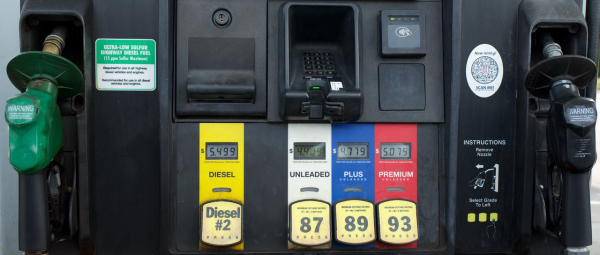
Fuel prices took a bit of a dip toward the end of the week here in Tennessee, if you call dropping from over $5/gallon for regular grade gasoline to just under $4.50/gallon a “dip”.
Diesel prices, however, are still well over the $5/gallon mark.

Consequently, the diesel-powered RV is sitting in storage instead of racking up highway miles.
It may be a business vehicle, but no business is immune to record high fuel prices. There’s simply no reason to drive it unnecessarily. I’m running short errands on the motorcycle rather than in the car - despite our record-setting high temperatures.
One hundred degrees on a motorcycle wearing a protective helmet, jacket and gloves is much more bearable when you realize you’re sweating, but getting 50+ MPG, not 24.3. Topping off a fuel tank for less than $15 is comforting even if it’s not always comfortable.
While there are still plenty of RVs on southern roadways, there don’t seem to be nearly as many with more distant origination license plates.
A pair recent surveys from TraderInteractive (RVTrader.com's online blog) finds many longer-distance road warriors have, indeed, modified summer travel plans.
In March, RVTrader surveyed more than 1,800 shoppers considering an RV trip within the next three months. In March, just over half (51%) surveyed told surveyors they’ve adjusted their trip plans.
Their newest survey shows that rising costs -across the board- have caused further adjustments.
Today, fifty seven percent say they’ve adjusted their plans.
Adjustments? They include traveling fewer miles, adjusting lengths of stays (fewer destinations/longer duration visits), and shortening the overall length of their trips.
Another twenty-one percent say rising costs caused the tough decision to cancel their RV travel plans entirely.
The latest survey also helps determine just how much is “too much” when it comes to fuel costs.
Like disparities in compensation, different parts of the country have very different pain thresholds.
But a whopping fifty percent of those 1,800 RVers surveyed said $5.00/gallon was their max.
Another twenty percent said the would stretch to $5.50/gallon, but no more.
Only nineteen percent said $6 was tolerable.
Should fuel costs rise to $6.50-$7/gallon only eleven percent said they’d be on the road.
It’s not all gloom-and-doom for dealers, although my decidedly un-scientific surveys of RV lots in my area show more inventory on-hand and discounts being offered -both were unimaginable last summer.
Of the RV owners who said they’re re-thinking their plans, ten percent of them said they were looking at cost savings in a decidedly different way.
They are considering trading their current RV for something more fuel-efficient.
Of course, they’re likely to be looking at reduced demand (and reduced trade-in values) for their less-efficient units.
Fuel efficiency is, of course, subject to interpretation. When it comes to Class A, B or C RVs, fuel “efficiency” is still considerably less than 20 MPG.
If you’re looking at a Class A, efficiency means between 10-13MPG. With a 100 gallon fuel tank, you’re looking at a 1000-1300 mile range. At $6 gallon, that’s a $600 fill-up. Ouch.
To give that some cost-per-mile relevance, let’s estimate fuel costs based on 12.5 MPG for 1,000 miles. That’s possible in virtually all classes of RVs.
You’ll use 80 gallons of fuel. At $6/gallon (a middle-ground estimate), you’re looking at $480 in fuel costs.
Traveling at a fuel-saving 60MPH (and ignoring all the dirty looks from all the drivers zooming past you on the interstate) you’re spending over $28/hour for fuel.
How much of an increase it that from last year? Significant.
Last summer, I traveled 2,580 miles round trip from my home to Rapid City, South Dakota. The Class C averaged a respectable 14.2/mpg. I used a total of just under 182 gallons of fuel.
The fuel cost? Just over $590 (NOTE: I’m not including the required DEF in the cost, just pumped diesel).
This summer, that same trip based on the same route and amount of fuel (again, not including the DEF costs -it has also gone up significantly) would cost $1,092. A 46% price increase.
And that’s an average cost. If the route has more distance with higher prices (likely), the cost goes even higher.
That’s why I’m not taking major road trips this year. And why many other RV owners have made the decision to adjust accordingly.
In the meantime, insurance, storage and depreciation costs continue. RV’s aren’t cost-free -even if you at stay home. And they still need “exercise” - the various HVAC/Water/Power systems deteriorate if they aren’t used. “Lot rot” isn’t just an expression used by car dealerships.
Finally, a very short note regarding the “gas tax holiday” the administration’s been pushing.
Before you start thinking it’s going to give you some much-needed relief at the pump, be aware that the relief that’s being promised by the administration is counting on state and local governments giving the same fuel tax-free holiday.
Don’t know about you, but I’m unaware of any state or local governments looking to give anything back revenue-wise right now.
They’re seeing from the same rising costs as the rest of us.
Without their participation the federal holiday savings you’re not likely to get enough relief to pay for a (federal) tax-free gallon of gas.
As always, we’ll keep you posted.
— Jim Shepherd